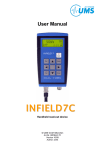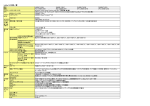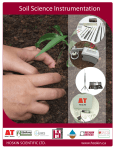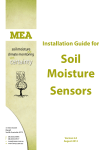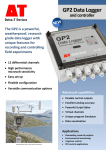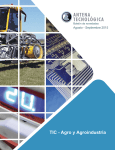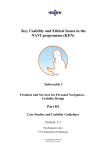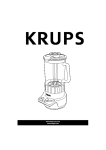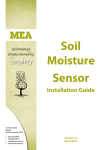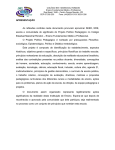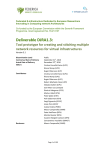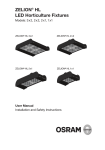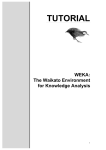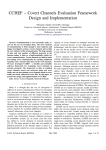Download a real time monitoring and control system targeted to
Transcript
A real time monitoring and control system targeted to support greenhouse automation & internet connectivity I. Gravalos, Z. Tsiropoulos and P. Xyradakis Department of Biosystems Engineering School of Agricultural Technology, Technological Educational Institute of Larissa Larissa Greece D. Moshou and D. Kateris Department of Hydraulics, Soil Science and Agricultural Engineering School of Agriculture Aristotle University Thessaloniki Greece Keywords: remote control, network, Web, user interface, sensor, air temperature, soil moisture Abstract Greenhouse Automation Networks (GANs) are an essential part of modern greenhouse operation and are aimed to increase the production efficiency. In this paper, we present a real-time monitoring and control system, which allows remote end-users to access and manage agro data through a computer network. Data sources include video signal, air temperature measured with digital thermometers and soil moisture detected with soil moisture sensors. The priority was to implement a system using a workstation which is accessible through a webpage, to collect and manage real data. Therefore we have developed and evaluated a new "User Interface" aimed to be considerably friendlier to users. The development and testing of the system proved to be satisfactory. INTRODUCTION Today there is a great interest in using automation and electronics for monitoring and controlling all the process on farms. In greenhouses the most important factors for the quality and productivity of plant growth are air temperature, humidity, light and carbon dioxide. Continuous monitoring of these environmental variables gives information to the horticulturalists to better understand the way each factor affects growth and how to manage maximal crop productivity (Timmerman and Kamp, 2003). In greenhouses horticulturalists realized quickly the benefits of automation and all its applications. The computers maintain these conditions by automatically firing and turning off boilers, opening and closing vents, turning on sprinklers and controlling shading (Cox and Moncaster, 1988). Information technology involves the transmission of data and automatic control in a remote place by using Web. Greenhouse Automation Networks (GANs) are networks that use different technologies for different services. These automation systems are performed as follows: first the acquisition devices make data collection and send the data to the corresponding local computer. However, the integration of these systems requires that the various electronic devices to co-operate automatically without human intervention. Therefore, in order to make GANs a practical reality, the standardization of the involved communications and networking aspects, is required. A great effort must be undertaken from research institutes and telecommunication industry for the development of standards for GANs. Basic characteristics should be offered by such standards as the simple installation, distributed control, and multiple applications (Kalogeras et al., 1995; Topalis et al., 2000; Gravalos et al., 2005). Networking technologies should either use existing wiring, such as telephone or electrical wires, or transmit data wirelessly. The rapid expansion of the Internet together with the mobile device technology, high speed connections and real-time remote management have made it possible for users to access information anywhere and any time (Feng et al., 2007). Jacobson et al. (1989) describe real-time greenhouse monitoring and control with an expert system. System software ran on a general-purpose microcomputer that was located 0.5 km away from the greenhouse. The remote microcomputer communicated via dedicated telephone line with a monitor/controller located in the greenhouse. Serôdio et al. (2001) described the major components of the implemented agricultural network and some of the results were achieved through its application to a set of greenhouses located at the north of Portugal. Mancuso and Bustaffa (2006) have applied sensors for the air temperature, relative humidity and soil temperature measurements on a wireless sensor network. They have also developed a Web-based plant monitoring application. The greenhouse horticulturalist can read the measurements over the Internet, and an alarm signal will be sent to his mobile phone by SMS or GPRS if some measurement variable changes rapidly. Liu et al. (2007) have developed and tested a WSN prototype for environmental monitoring inside the greenhouse. They are using a star topology network of Crossbow MICAz motes. The motes measure temperature, humidity and soil moisture, and send their measurements to the sink node in five minutes intervals. Sink node is a combination of MICAz mote and MIB510 board with data terminal. The terminal with ARM processor module shows the latest measurements in LCD-screen inside the greenhouse and delivers the data to the main PC by using GSM module. Ahonen et al. (2008) integrated three commercial sensors with Sensinode’s sensor platform to measure four environmental key variables in greenhouse control. The system feasibility was verified in a simple star topology setup in a tomato greenhouse. Kang et al. (2008) propose a greenhouse auto control system based on wireless sensor network. Each sensor node measures temperature, humidity, leaf temperature and leaf wetness in the greenhouse, and then transfer them to the sink node. This system can automatically control windows, fans and heaters of the greenhouse based on this data. The horticulturalist can monitor the greenhouse information anywhere by using Web. Gal (2009) presents a remote monitoring and control platform based on a widely used PLC and its communication module. Thanks to the today’s satellite network coverage, the system is ready to support the development of an extended greenhouses network. Matijevics and Simon (2010) describe the implementation and configuration of the wireless sensor network using the Sun SPOT platform for the control of the greenhouse microclimatic condition. Bridging the gap between farm production automation systems and remote users has always posed challenges. In this paper we have to implement a monitoring and control system for greenhouse applications. Data sources are video signal taken through a web camera, temperature measured with digital thermometers and soil moisture detected with soil moisture sensors. In remote agricultural monitoring and control services the video and data transmission is crucial due to heterogeneous hardware and software environments and the fact that in many rural areas the existing telecommunication infrastructure cannot support applications requiring high data transmissions speed. MATERIALS AND METHODS The general architecture of the monitoring and control system is depicted in Fig. 1. The hardware and software monitoring system has been realized on the basis of a Local Area Network (LAN). Related to this point, we have used the current network infrastructure of the Biosystems Engineering Department (Technological Educational Institute of Larissa, Greece). We used a Personal Computer (Intel Core i7-950 3.06 GHz, 6GB DDR3 RAM) in which we’ve installed a Windows Server 2008 R2 (Internet Information Services “IIS” 7.5, .NET Framework 4.0). Internet Information Services (IIS) 7.5 is a flexible platform with enhanced support for multiple application development platforms and media content delivery. Microsoft SQL server database was used for the storage of all data taken from the various components of the system (sensors, actuators etc). The system was implemented over TCP/IP communication with a known server IP address and the server can accept any over 32.000 connections simultaneously. The clients can use any web browser and any operating system to display contents retrieved from the server using the Hyper Text Transfer Protocol (HTTP). A servlet engine runs within the HTTP server. HTTP server and servlet engine are thereby interchangeable components. However, the entire application logic resides at the server. Web inspection systems are used for inspection tasks in numerous production areas. The on-line web inspection is a complex problem and the research in this field is still open. In our study, the system architecture has been designed for observation of the physical world in the greenhouse. It consists of video device, software and a lighting system. A Video Camera (PT 22X Zoom) with motion detection and high resolution was tested and used. This video camera is a high-performance device for use in a professional and demanding surveillance situation. It supports multiple network protocols for MPEG4/MJPEG live video transmission. The live view, record and operation of the camera it is done easily via the supplied video viewer software or the web browser. Video surveillance over IP network infrastructure is available and easily accessible from anywhere, anytime. The camera is connected to the workstation PC with a RJ45 cable. It uses QuickTime player for streaming at the various browsers (Internet Explorer, Mozilla Firefox etc). The client broadcasts the frames through the network in an acceptable time depended on the network connection speed. In our system, the measuring devices have an essential monitoring function. They simply indicate the conditions of the greenhouse environment. The temperature-measured system was based on an integrated circuit temperature sensor DS 1621 and a voltage regulator LM 2936Z-5 (Fig. 2). The temperature sensor DS 1621 (Dallas Semiconductor) is a digital thermometer and thermostat device, which measures temperature from -55 ºC to 125 ºC. The signals of the temperature sensors were collected via a Keithley Instruments Inc. KPCI-3116A PCI Multifunction Board. The other objective of this paper is the soil moisture monitoring. Four (4) ThetaProbe ML2x soil moisture sensors were placed at the soil of the greenhouse. The ThetaProbe measures volumetric soil moisture content, θv, by the well established method of responding to changes in the apparent dielectric constant. These changes are converted into a DC voltage, virtually proportional to soil moisture content over a wide working range. ThetaProbe consists of a waterproof housing which contains the electronics, and, attached to it at one end, four sharpened stainless steel rods that are inserted into the soil. The probe generates a 100 MHz sinusoidal signal which is applied to a specially designed internal transmission line that extends into the soil by means of the array of four rods. The impedance of this array varies with the impedance of the soil, which has two components - the apparent dielectric constant and the ionic conductivity. The accuracy of these sensors is: ±0.01 m3.m-3, 0 to 40°C, ±0.02 m3.m-3, 40 to 70°C, and their response time is less than 0.5 sec to 99% of change. The signals of the ThetaProbe soil moisture sensors were collected via Dynamax’s datalogger that is an ideal solution for the problem of logging data from one, two or four sensors. Despite its small size, the datalogger has several impressive features: logging intervals programmable from every 0.5 seconds up to once every 9 hours, and data storage capacity of 32,000 samples. The connection between the datalogger and PC’s 9-pin Com Port (serial) is implemented via PC interface cable. The greenhouse control is made from with a website page (Fig. 3). Through that page user can turn greenhouse lights on or off, set the desirable temperature of the greenhouse and determine the soil moisture value at which the irrigation will start. For these commands above we’ve created a VB (Visual Basic) code which runs from the website and is capable of setting up all these automations. All user actions are been recorded and stored at a table on the website database. RESULTS AND DISCUSSION The role of the end user (horticulturalist) in such systems is fundamental, at various stages: selecting the appropriate data to be archived, formulating and refining queries, and looking for responses to these queries. Satisfied quality of video sequences can be achieved in the area of 240 kbps, while the rate is scalable up to 2Mbps with the appropriate increase in quality. Furthermore, the appropriate illumination technique has a significant role in video images capture. The incorrect lighting causes low contrast, shadings, flickers, and changes the faithfulness of the video image. A fluorescent tube, which provides 3200 Lux intensity and operates at 40 kHz, is an accepted lighting system. For colour rendering improvement, the lighting tube must operate at temperature 2900-3200 K and the colour rendering index must be higher than 85. Our purpose is not to acquire precise range information in this work, but to provide smooth video image sequences in real time for monitoring static events in greenhouse environment. Taking in consideration the above approach, the preferred frame size was the maximum provided by the video camera (352x240 pixels). We used MPEG4 algorithm to perform the compression, and it was decided to set the quality factor to HIGH and the frame rate to 15fps. The first results show that the quality of video images is satisfactory (Fig. 4). Using this video camera streaming method, the network’s bandwidth is used more efficiently and leaves a free space for supplementary data broadcasting such as data from soil moisture sensors and digital thermometers. The soil moisture status requires periodical measurements in the greenhouse area, from which can project when the next irrigation would occur and the depth of water that should be applied. The system takes a reading of the amount of water in the soil from 4 different places into the greenhouse. The digital thermometers were installed into the greenhouse and operated continually. End user through Interface collected the air temperature data streams. The measured values are been refreshed automatically. There are many search options for the users of the system. Users can see the recorded soil moisture and air temperature values of the greenhouse and their averages per day, month, year, or select to view the data of specific dates. The system records at the website database the values of the 10 temperature sensors and the 4 soil moisture sensors every 3 seconds and 1 minute respectively. A total of 20160 values are recorded daily (14440 via the temperature sensors and 5760 from the soil moisture sensors). In Fig. 5 is shown an example of the Historical data pages that allows the user to view all the recorded data. More specifically it shows past week’s average values for each sensor, as well as the average value of air temperature and the soil moisture daily. The agricultural monitoring and control systems are characterized by a high degree of heterogeneity. Different electronic devices, provided by different suppliers, need to communicate over different communicating protocols. Therefore, the basic trends of the agricultural production environments today are the change from centralized control and monitoring architectures to distributed systems. These aspects create the need for the development of special software tools that support the design of new monitoring and control applications. The integration of the real-time Internet monitoring and reporting to the agricultural systems communication hierarchy will also lead to a further increase in agricultural system distribution, while it is expected to provide novel Network Information Services. CONCLUSIONS A simple but reliable monitoring and control system for greenhouse applications was developed. Data sources are remotely accessed because of a built HTML page passing over TCP/IP connection. The flexibility of the system was the one with the major advantages for its adoption by the end users. It appeals to beginners as well as to the expert users. Furthermore, the cost of software and hardware was minimised by using a personal computer and the other components are obtained from the Internet market. The development and testing of the system was also satisfactory. The system worked consistently with no failures throughout the test period. The above monitoring and control system is in progress. The highest priority is to implement a cheap net based system to collect and aggregate real data. Another kind of environmental variables that could be monitored and controlled in a near future are the air humidity and carbon dioxide concentration. We also plan to investigate the evaluation of a new "User Interface" in order to be considerably more comfortable and friendly for end users. Literature Cited Ahonen, T., Virrankoski, R. and Elmusrati, M. 2008. Greenhouse monitoring with wireless sensor network. 2008 IEEE/ASME International Conference on Mechatronic and Embedded Systems and Applications. Beijing, China October 1215. p. 403-408. Cox, S.W.R. and Moncaster, M.E. 1988. Instrumentation in Agricultural Engineering. Agricultural Engineer 43:127-139. Delta-T Devices Ltd 1999. ThetaProbe, Soil Moisture Sensor, Type ML2x. User Manual. Cambridge. Dynamax, Inc. 2005. Installation and Operation Manual for Soil Moisture Dataloggers THLog-1, THLog-2, and THLog-4. Manual Version 1.0. Houston. Feng, X., Yu-Chu, T., Yanjun, L. and Youxian, S. 2007. Wireless Sensor/Actuator Network Design for Mobile Control Applications. Sensors 7:2157-2173. Jacobson, B.K., Jones, P.H., Jones, J.W. and Paramore, J.A. 1989. Real-Time Greenhouse Monitoring and Control with an Expert System. Computers and Electronics in Agricultural 3:273-285. Kalogeras, A., Samatis, K., Efstathiou, K., Lyras, P., Zapantes, G., Fountas, P., Koubias, S. and Papadopoulos, G. 1995. A Network Management Approach for a Distributed Industrial Application and the Related Implementation. IEEE Int. Symp. on Industrial Electronics. Athens, Greece 20-23 June. p. 463-465. Kang, B.J., Park, D.H., Cho, K.R., Shin, C.S., Cho, S.E. and Park, J.W. 2008. A Study on the Greenhouse Auto Control System based on Wireless Sensor Network. International Conference on Security Technology. Sanya, China 13–15 December. p. 41-44. Liu, H., Meng, Z. And Cui, S. 2007. A Wireless Sensor Network Prototype for Environmental Monitoring in Greenhouses. International Conference at Wireless Communications, Networking and Mobile Computing. Shanghai, China 21-25 September. p. 2344–2347. Mancuso, M. and Bustaffa, F. 2006. A Wireless Sensors Network for Monitoring Environmental Variables in a Tomato Greenhouse. 6th IEEE International Workshop on Factory Communication Systems. Torino, Italy 28-30 June. p. 107110. Matijevics, I. and Simon, J. 2010. Control of the Greenhouse’s Microclimatic Condition using Wireless Sensor Network. The IPSI BgD Transactions on Internet Research 6:35-38. Gal, N. 2009. Remote Ethernet PLC Networking and Control. 17th Telecommunications forum. Belgrade, Serbia 24-26 November. p. 759-762. Gravalos, I., Raptis, I., Varvoutis, I. and Tsikas, D. 2005. A Distributed Monitoring System for Agricultural Applications. II International Scientific Conference on Information Technologies and Control Engineering in Management of Production Systems. Prague, Czech Republic 20-22 September. p. 60-67. Serôdio, C., Boaventura-Cunha, J., Morais, R., Couto, C. and Monteiro, J. 2001. A networked platform for agricultural management systems. Computers and Electronics in Agriculture 31:75–90. Timmerman, G.J. and Kamp, P.G.H. 2003. Computerised Environmental Control in Greenhouses. IPC-Plant, Ede. Topalis, E., Orphanos, G., Koubias, S. and Papadopoulos, G. 2000. A Generic Network Management Architecture Targeted to Support Home Automation Networks and Home Internet Connectivity. IEEE Transaction on Consumer Electronics 46:44-51. Fig. 2. Photograph of the temperature sensor board Fig. 1. Overview of the system architecture Fig. 3. Greenhouse control and real time data Fig. 4. Video monitoring Fig. 5. Last’s week air temperature and soil moisture data









